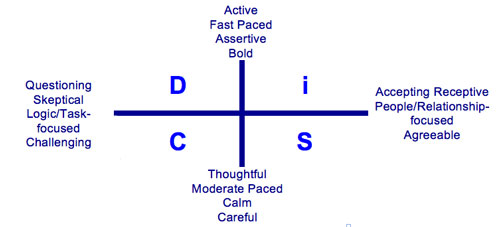Popular Personality Questionnaires
Personality questionnaires are usually used in conjunction with aptitude tests, interviews, and management exercises to assess your ability to perform the role you are applying for.
The timeframe allocated to these questionnaires provides a natural limit to how many questions can be asked. This is especially true for online questionnaires.
 |
The most common forms of personality questionnaires used in recruitment are:
• MBTI indicator
• MMPI-2-RF
• SHL OPQ32r
• D.I.S.C. behavioral model.
Myers-Briggs Type Indicator (MBTI)
The MBTI started off as a questionnaire to help women entering the workforce during World War II to understand which occupations best suited their personality. By the 1960s this original test had been refined to create the MBTI. This measures they way individuals prefer to make decisions and how they view their environment. Its popularity comes from its ability to be used in a wide variety of situations and the ease with which its results can be interpreted.
The MBTI questionnaire asks a series of forced choice questions. This means that a person must choose one of the two proposed answers or skip to the next question. These answers are either short statements that reflect opposite preferences or views, or word pairs. It shows which characteristics, or behaviors, an individual prefers rather than how they will act in the workplace.
Whilst it is commonly used in recruitment its use is controversial. This is because it measures preferences not personality, making it a more appropriate tool for developing individuals. But it is useful when organizations want to develop future leaders or improve team performance.
Some of the issues you should be aware of when asked to complete a MBTI test are that it does not have a predictive validity, and is not able to distinguish between competencies and preferences. This knowledge will influence the way in which you prepare and the amount of time you devote to this activity.
Minnesota Multiphasic Personality Inventory (MMPI-2-RF)
The MMPI was first published in the 1940s and is one of the most widely used and objective tests to assess the personality traits of adults and psychopathology. Despite it being heavily biased towards treatment of clinical patients it has been used in the form of MMPI-2-RF since 2008 to assess suitability for certain professions such as the police.
Whilst it has undergone several iterations since its inception, the nature and complexity of this personality test still mean that it is recommended to have a trained individual interpret the test results.
MMPI-2-RF uses more modern methods including validity scales to ensure its scores are theoretically grounded. The more focused design of the questions used in the MMPI-2-RF test make it suitable to take online.
The SHL OPQ32r
SHL is the market leader in providing organizations with a wide variety of science-based assessments that help select and develop individuals. Their proprietary personality questionnaire OPQ32r is a business-based occupational model of personality. SHL describes the questionnaire as:
'The Occupational Personality Questionnaire (OPQ32r) provides an indication of an individual's perception of their preferred behavioral style at work and likely performance against important job competencies. It is designed specifically for use in a business environment and assesses 32 specific personality characteristics.' (Source: http://ceb.shl.com/uk/solutions/products/inc/detail.cfm?id=710)
The questionnaire measures aspects of a person's behavior that are not easily recognized from resumes and in interviews. It is also quick and easy to use during the recruiting process as it only takes 25 minutes to complete online.
Organizations are keen to use an Occupational Personality Questionnaire (OPQ) because they are able to target the competencies a role requires for an individual to perform successfully in that role. It is widely used by both public and private organizations throughout the world to ensure they take on those individuals who provide the best match to the role's competencies.
The OPQ is designed to provide organizations with information about the aspects of an individual's behavioral style that will impact on their performance of competencies at work. The reports and graphs produced by the OPQ32r summarize an individual's performance against the competencies of the role. This is extremely useful in circumstances where large numbers of personnel need to be assessed following a merger or acquisition.
D.I.S.C. Behavioral Model
This model looks at the styles and preferences of a person's behavior to discern their personality. Its foundations lie in the study by William Marston of the effect a person's sense of will and power had on their behavior and personality. Marston researched how to accurately measure 'the energy of behavior and consciousness' which resulted in the DISC acronym.
 |
The four preferences that make up the acronym are Dominance, Influence, Steadiness, and Conscientiousness, and these are often said to resemble the four humors. The top row of the diagram represents the aspects of extroversion while the bottom row represents the introversion aspects of personality. An individual's personality is measured along the horizontal axis, which denotes guarded versus openness, while the vertical axis represents a person's behavior from passivity at the bottom to assertiveness at the top.
The model uses word associations to assess an individual's preferences.
Dominance - relates to control, power, and assertiveness.
Influence - relates to social situations and communication.
Steadiness - relates to patience, persistence, and thoughtfulness.
Conscientiousness - relates to structure and organization.
Any potential employer needs to assess the results from the DISC model in conjunction with the type of personality that best matches the job specifications and competencies. When using this and any of the other personality questionnaires to select candidates for a role results should be assessed by comparing them to the results of those successfully performing the role.
You may also be interested in:
Management Personality Tests | The 'Big 5' Aspects of Personality | Popular Personality Questionnaires | Validity Scales | Defining Your Work Personality | 'Make or Break' Questions.



